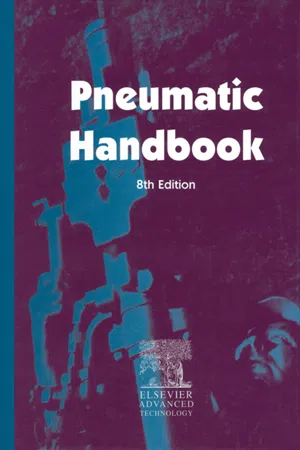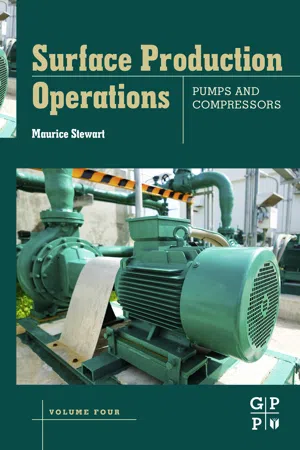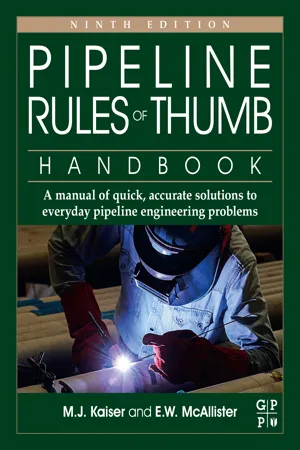Technology & Engineering
Isentropic Efficiency of Compressor
The isentropic efficiency of a compressor is a measure of how effectively the compressor is able to compress a gas with minimal energy loss. It is expressed as the ratio of the actual enthalpy increase to the ideal enthalpy increase in an isentropic process. A higher isentropic efficiency indicates that the compressor is operating more effectively.
Written by Perlego with AI-assistance
Related key terms
Related key terms
1 of 4
Related key terms
1 of 3
3 Key excerpts on "Isentropic Efficiency of Compressor"
- eBook - ePub
- A. Barber(Author)
- 1997(Publication Date)
- Elsevier Science(Publisher)
T is the temperature of the air at the point of use, which can be any value between ambient and compressor delivery. If air can be used at high temperature, there is more potential power available but, as with conventional systems, the temperature normally falls to the ambient either in the receiver or in its passage along the distribution mains.The definition of potential efficiency follows from potential power: Isentropic power has been chosen as the denominator, but any calculation of power can be used – isothermal if the compressor works on that cycle or polytropic if the index of compression is known. Now since isentropic power is given by the potential efficiency becomes:[3]T is normally equal to T2 , but the expression indicates that if the air can be used at a higher temperature than ambient, the efficiency is improved. This is rarely likely to be possible in practice, but if circumstances are such that it can be used in that way, there are advantages to be gained. The second conclusion to be drawn from this expression is that the efficiency is a function of pressure ratio.A plot of the potential efficiency is given in Figure 1 .FIGURE 1 – Variation of compressor efficiencies with pressure ratio for two level mode.On the same figure is a plot of the overall efficiency measured from experiments performed at FPC on a modified vane compressor. The overall efficiency, taking into account mechanical losses in the compressor drive, is rather less than the potential efficiency.When comparing theoretical efficiency with the overall efficiency, it appears that the mechanical efficiency alone is of the order of 67%. On the face of it this seems rather lower than one would expect, but the values are obtained at an early stage in the development of the concept, and it is likely that they would improve with experience. - Maurice Stewart(Author)
- 2018(Publication Date)
- Gulf Professional Publishing(Publisher)
Compression theory is derived from the laws of thermodynamics. The theory is applicable to both positive displacement and continuous flow compressors.The two processes used to calculate thermodynamic relationships are isentropic (adiabatic) and polytropic. The polytropic process is a modification of the adiabatic process, involving an efficiency to more closely represent actual conditions. These calculations are the basis for determining capacity, driver size, and mechanical design. The following discussion explains the differences and when they are used.Fig. 7.12 shows the compression paths of three theoretical processes: isothermal, isentropic, and polytropic. The theoretical work needed for isothermal compression is described by the area ABEF. It can be seen that the isothermal work is appreciably less than that of the isentropic area ABDF. Similarly, the isentropic area is smaller than the polytropic area ABCF. Since the isothermal area is considerably less than the isentropic and polytropic it would be the process for greater compression economy.None of the three processes is commercially attainable; however, they are useful as a basis for calculations and comparisons.Fig. 7.12 Theoretical compression paths on P –V diagram for three different processes.The differences can be attributed to differences in heat transfer (cooling). The isothermal process would require continuous cooling during compression to negate the entire temperature rise. It is never commercially possible to remove the heat of compression as rapidly as it is generated. Thus, this process is not as logical a working base as the adiabatic although it was used for many years. Compressors are designed for as much heat removal as possible. In an actual compressor the theoretical isentropic discharge temperature can sometimes be achieved by a moderate amount of cooling during compression. Even so, the resultant process will not be purely isentropic due to other losses in an actual machine. The polytropic path BC best represents an actual process where there is no cooling during compression.- eBook - ePub
Pipeline Rules of Thumb Handbook
A Manual of Quick, Accurate Solutions to Everyday Pipeline Engineering Problems
- M.J. Kaiser, E.W. McAllister(Authors)
- 2022(Publication Date)
- Gulf Professional Publishing(Publisher)
The efficiency, expressed in percent, should be defined in regard to the base at which the theoretical power was calculated, whether adiabatic or isothermal. Mechanical efficiency is the ratio of the indicated horsepower of the compressor cylinder to the brake horsepower delivered to the shaft in the case of a power-driven machine. It is expressed in percent. Overall efficiency is the product, expressed in percent, of the compression efficiency and the mechanical efficiency. It must be defined according to the base, adiabatic isothermal, which was used in establishing the compression efficiency. Piston rod gas load is the varying, and usually reversing, load imposed on the piston rod and crosshead during the operation, by different gas pressures existing on the faces of the compressor piston. The maximum piston rod gas load is determined for each compressor by the manufacturer, to limit the stresses in the frame members and the bearing loads in accordance with mechanical design. The maximum allowed piston rod gas load is affected by the ratio of compression and also by the cylinder design, i.e. whether it is single- or double-acting. Performance calculations for reciprocating compressors Piston displacement Single-acting compressor: (1) Double-acting compressor without a tail rod: (2) Double-acting compressor with a tail rod: (3) Single-acting compressor compressing on the frame end only: (4) where: P d = Cylinder displacement, cu ft/min, S t = Stroke length, in, N = Compressor speed, number of compression strokes/min, D = Cylinder diameter, in, d = Piston rod diameter, in. Volumetric efficiency (5) where: E v = Volumetric efficiency, f = Ratio of discharge compressibility to suction compressibility Z 2 /Z I, r p = Pressure ratio, k = Isentropic exponent, C = Percent clearance, L = Gas slippage factor. Let L = 0.3 for lubricated compressors (6) These values are approximations, and the exact value may vary by as much as an additional
Index pages curate the most relevant extracts from our library of academic textbooks. They’ve been created using an in-house natural language model (NLM), each adding context and meaning to key research topics.
Explore more topic indexes
Explore more topic indexes
1 of 6
Explore more topic indexes
1 of 4


